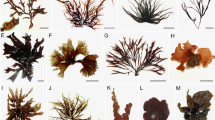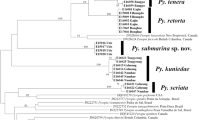Abstract
This paper is part of an extensive study on the biodiversity of the macroalgal flora of São Paulo state, SE Brazil. Previous assessments were based only on morphological descriptions. Here, we tested the effectiveness of DNA barcoding, in comparison with morphological observations for the recognition and cataloging of species. The focus of this study is the genus Porphyra, which is a conspicuous component of the upper intertidal on rocky shores of this region. With five currently accepted species, we have sequenced three short markers: cox1, cox2–3 spacer and UPA to establish the first DNA barcode database for the Porphyra species from the Brazilian coast. The three markers, although with different evolution rates, recovered a cryptic species (Porphyra sp. 77), grouped two different species (Porphyra drewiana and Porphyra spiralis) that are being synonymized, and finally indicated that varieties within P. acanthophora and P. spiralis are merely morphological, with no sequence divergence in the studied molecular markers.


Similar content being viewed by others
References
Brodie J, Bartsch I, Neefus C, Orfinidis S, Bray T, Mathieson A (2007) New insights into the cryptic diversity of the North Atlantic–Mediterranean ‘Porphyra leucosticta’ complex: P. olivii sp. nov. and P. rosengurttii (Bangiales, Rhodophyta). Eur J Phycol 42:3–28
Brodie J, Mortensen AM, Ramirez ME, Russell S, Rinkel B (2008) Making the links: towards a global taxonomy for the red algal genus Porphyra (Bangiales, Rhodophyta). J Appl Phycol 20:939–949
Broom JE, Jones WA, Hill DF, Knight GA, Nelson WA (1999) Species recognition in New Zealand Porphyra using 18S rDNA sequencing. J Appl Phycol 11:421–428
Broom JE, Nelson WA, Yarish C, Jones WA, Rosas RA, Rosas LEA (2002) A reassessment of the taxonomic status of Porphyra suborbiculata, Porphyra carolinensis and Porphyra lilliputiana (Bangiales, Rhodophyta) based on molecular and morphological data. Eur J Phycol 37:227–235
Butterfield NJ (2000) Bangimorpha pubescens n. gen., n. sp.: implications for the evolution of sex, multicellularity and the Mesoproterozoic–Neoproterozoic radiation of eukaryotes. Paleobiology 26:386–404
Clarkston BE, Saunders GW (2010) A comparison of two DNA barcode markers for species discrimination in the red algal family Kallymeniaceae (Gigartinales, Florideophyceae), with a description of Euthora timburtonii sp. nov. Botany 88:119–131
Coll J, Oliveira EC (2001) Porphyra drewiana, a new species of red algae (Bangiales, Rhodophyta) from Brazil. Phycol Res 49:67–72
Conklin KY, Kurihara A, Sherwood AR (2009) A molecular method for identification of the morphologically plastic invasive algal genera Eucheuma and Kappaphycus (Rhodophyta, Gigartinales) in Hawaii. J Appl Phycol 21:691–699
Drew KM (1949) Conchocelis-phase in the life history of Porphyra umbilicalis (L.) Kütz. Nature 164:748–749
Guiry MD, Guiry GM (2010) AlgaeBase. World-wide electronic publication, National University of Ireland, Galway. http://www.algaebase.org. Accessed 25 November 2010
Hall TA (1999) BioEdit: a user-friendly biological sequence alignment editor and analysis program for Windows 95/98/NT. Nucl Acids Symp Ser 41:95–98
Hebert PDN, Cywinska A, Ball SL, de Waard JR (2003) Biological identifications through DNA barcodes. Proc R Soc Lond B 270:313–321
Kimura M (1980) A simple method for estimating evolutionary rates of base substitutions through comparative studies of nucleotide sequences. J Mol Evol 16:111–120
Kucera H, Saunders GW (2008) Assigning morphological variants of Fucus (Fucales, Phaeophyceae) in Canadian waters to recognized species using DNA barcoding. Botany 86:1065–1079
Kunimoto M, Kito H, Mizukami Y, Murase N, Levine I (2003) Molecular features of a defined genetic marker for the determination of the Porphyra tenera lineage. J Appl Phycol 15:337–343
Le Gall L, Saunders GW (2010) DNA barcoding is a powerful tool to uncover algal diversity: a case study of the Phyllophoraceae (Gigartinales, Rhodophyta) in the Canadian flora. J Phycol 46:374–389
Lindstrom SC (2008) Cryptic diversity, biogeography and genetic variation in Northeast Pacific species of Porphyra sensu lato (Bangiales, Rhodophyta). J Appl Phycol 20:501–512
McDevit DC, Saunders GW (2010) A DNA barcode examination of the Laminariaceae (Phaeophyceae) in Canada reveals novel biogeographical and evolutionary insights. Phycologia 49:235–248
Milstein D, Oliveira MC (2005) Molecular phylogeny of Bangiales (Rhodophyta) based on small subunit rDNA sequencing: emphasis on Brazilian Porphyra species. Phycologia 44:212–221
Milstein D, Oliveira MC, Martins FM, Matioli SR (2008) Group I introns and associated homing endonuclease genes reveals a clinal structure for Porphyra spiralis var. amplifolia (Bangiales, Rhodophyta) along the Eastern coast of South America. BMC Evol Biol 8:308. doi:10.1186/1471-2148-8-308
Müller KM, Sheath RG, Vis ML, Crease TJ, Cole KM (1998) Biogeography and systematics of Bangia (Bangiales, Rhodophyta) based on the RuBisCo spacer, rbcL gene and 18S rRNA gene sequences and morphometric analyses. 1. North America. Phycologia 37:195–207
Müller KM, Cannone JJ, Sheath RG (2005) A molecular phylogenetic analysis of the Bangiales (Rhodophyta) and description of a new genus and species, Pseudobangia kaycoleia. Phycologia 44:146–155
Neefus CD, Mathieson AC, Klein AS, Teasdale B, Gray T, Yarish C (2002) Porphyra birdiae sp. nov. (Bangiales, Rhodophyta): a new species from the northwest Atlantic. Algae 17:203–216
Nelson WA, Broom JES (2005) Contributions of molecular biology to understanding systematics and phylogeny in the order Bangiales. Nat Hist Res Spec Issue 8:1–12
Niwa K, Aruga Y (2003) Rapid DNA extraction from conchocelis and ITS-1 rDNA sequences of seven strains of cultivated Porphyra yezoensis (Bangiales, Rhodophyta). J Appl Phycol 15:29–35
Oliveira EC (1977) Algas Marinhas Bentônicas do Brasil. Thesis, University of São Paulo
Oliveira EC, Coll J (1975) The genus Porphyra C. Ag. (Rhodophyta-Bangiales) in the American South Atlantic. I. Brazilian species. Bot Mar 18:191–197
Oliveira MC, Ragan MA (1994) Variant group I introns in the small subunit ribosomal DNA of the red alga Porphyra spiralis var. amplifolia. Mol Biol Evol 11:195–207
Oliveira MC, Kurniawan J, Bird CJ, Rice EL, Murphy CA, Singh RK, Gutell RR, Ragan MA (1995) A preliminary investigation of the order Bangiales (Bangiophycidae, Rhdophyta) based on sequences of the nuclear small-subunit ribossomal RNA genes. Phycol Res 43:71–79
Presting GG (2006) Identification of conserved regions in the plastid genome: implications for DNA barcoding and biological function. Can J Bot 84:1434–1443
Ratnasingham S, Hebert PDN (2007) BOLD: the Barcode of Life Data System (http://www.barcodinglife.org). Mol Ecol Notes 7:355–364
Robba L, Russell SJ, Barker GL, Brodie J (2006) Assessing the use of the mitochondrial cox1 marker for use in DNA barcoding of red algae (Rhodophyta). Am J Bot 93:1101–1108
Ruangchuay R, Notoya M (2007) Reproductive strategy and occurence of gametophytes of Thai laver Porphyra vietnamensis Tanaka et Pham-Hoang Ho (Bangiales, Rhodophyta) from Songkhla Province. Kasetsart J (Nat Sci) 41:143–152
Saunders GW (2005) Applying DNA barcoding to red macroalgae: a preliminary appraisal holds promise for future application. Phil Trans R Soc B 360:1879–1888
Saunders GW (2008) A DNA barcode examination of the red algal family Dumontiaceae in Canadian waters reveals substantial cryptic species diversity. 1. The foliose Dilsea–Neodilsea complex and Weeksia. Botany 86:773–789
Saunders GW (2009) Routine DNA barcoding of Canadian Gracilariales (Rhodophyta) reveals the invasive species Gracilaria vermiculophylla in British Columbia. Mol Ecol Resour 9:140–150
Saunders GW, McDonald B (2010) DNA barcoding reveals multiple overlooked Australian species of the red algal order Rhodymeniales (Florideophyceae), with resurrection of Halopeltis J. Agardh and description of Pseudohalopeltis gen. nov. Botany 88:639–667
Sherwood AR, Presting GG (2007) Universal primers amplify a 23S rDNA plastid marker in eukaryotic algae and cyanobacteria. J Phycol 43:605–608
Sherwood AR, Vis ML, Entwisle TJ, Necchi O Jr, Presting GG (2008a) Contrasting intra versus interspecies DNA sequence variation for representatives of the Batrachospermales (Rhodophyta): insights from a DNA barcoding approach. Phycol Res 56:269–279
Sherwood AR, Chan YL, Presting GG (2008b) Application of universally amplifying plastid primers to environmental sampling of a stream periphyton community. Mol Ecol Resour 8:1011–1014
Stiller JW, Waaland JR (1993) Molecular analysis reveals cryptic diversity in Porphyra (Rhodophyta). J Phycol 29:506–517
Tamura K, Dudley J, Nei M, Kumar S (2007) MEGA4: Molecular Evolutionary Genetics Analysis (MEGA) software version 4.0. Mol Biol Evol 24:1596–1599
Thompson J, Higgins DG, Gibson TJ (1994) CLUSTAL W: improving the sensitivity of progressive multiple sequence alignment through sequence weighting, position-specific gap penalties and weight matrix choice. Nucleic Acids Res 22:4673–4680
Turner NJ (2003) The ethnobotany of edible seaweed (Porphyra abbottae and related species; Rhodophyta: Bangiales) and its use by First Nations on the Pacific coast of Canada. Can J Bot 81:283–293
Walker RH, Brodie J, Russell S, Irvine LM, Orfanidis S (2009) Biodiversity of coralline algae in the Northeast Atlantic including Corallina caespitosa sp. nov. (Corallinoideae, Rhodophyta). J Phycol 45:287–297
Yoshida T, Notoya M, Kikuchi N, Miyata M (1997) Catalogue of species of Porphyra in the world, with special reference to the type locality and bibliography. Nat Hist Res Spec Issue 3:5–18
Zuccarello GC, Burger G, West JA, King RJ (1999) A mitochondrial marker for red algal intraspecific relationships. Mol Ecol 8:1443–1447
Acknowledgements
Fundação de Amparo a Pesquisa do Estado de São Paulo (FAPESP) and Conselho Nacional de Desenvolvimento Científico e Tecnológico (CNPq, Brazil) A.S. Medeiros thanks CAPES for scholarship. The authors thank Carolina O. Franco for technical assistance.
Author information
Authors and Affiliations
Corresponding author
Rights and permissions
About this article
Cite this article
Milstein, D., Medeiros, A.S., Oliveira, E.C. et al. Will a DNA barcoding approach be useful to identify Porphyra species (Bangiales, Rhodophyta)?. J Appl Phycol 24, 837–845 (2012). https://doi.org/10.1007/s10811-011-9702-3
Received:
Revised:
Accepted:
Published:
Issue Date:
DOI: https://doi.org/10.1007/s10811-011-9702-3




